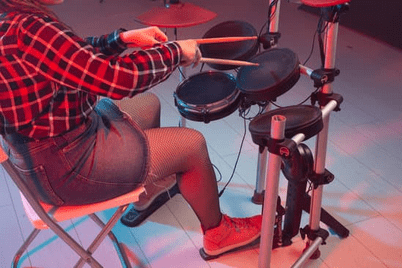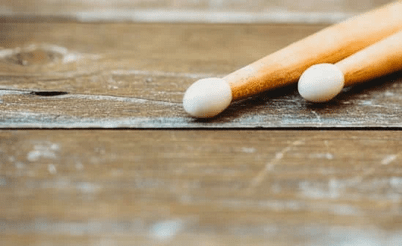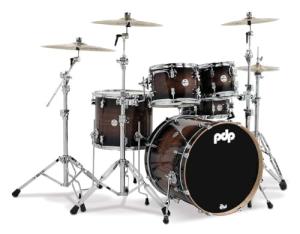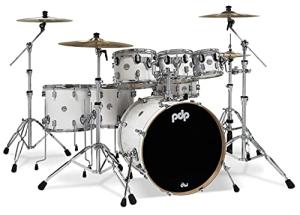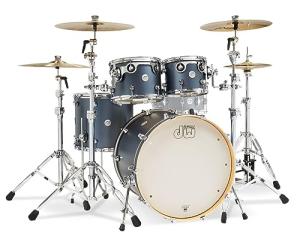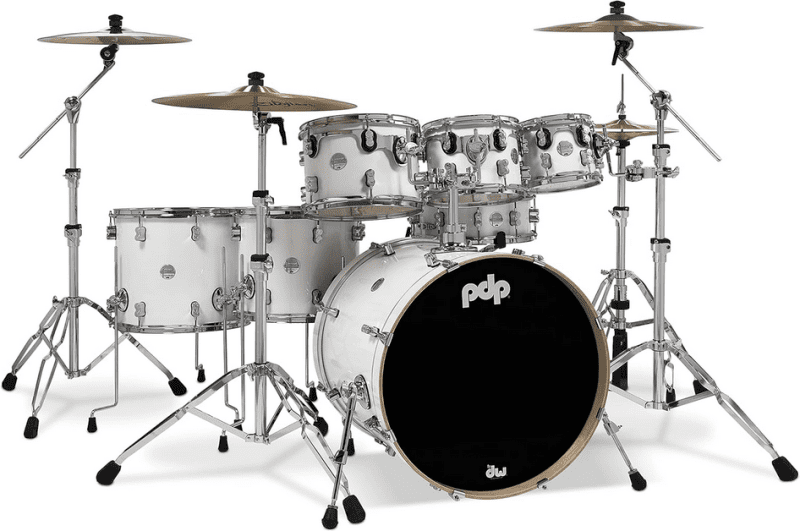Exercises for Lightning-Fast Performances
Drumming speed is a crucial skill for any aspiring drummer. Fast hands can make the difference between a good beat and an amazing one.
Regular practice of specific exercises can help drummers improve their hand speed and overall performance.
Many drummers struggle with speed, but it's a skill that can be learned and improved over time.
The key is to focus on proper technique and start slow.
As drummers build muscle memory and control, they can gradually increase their tempo.
This approach helps prevent bad habits and ensures clean, precise movements.
There are many exercises and techniques that can boost hand speed for drumming. These range from simple rudiments to more complex patterns.
By incorporating these into daily practice routines, drummers can see significant improvements in their speed and control.
Key Takeaways
- Regular practice of specific exercises improves hand speed for drumming
- Proper technique and gradual tempo increases are essential for developing speed
- A mix of simple and complex patterns in daily practice routines enhances overall drumming performance
Understanding the Basics
Fast drumming starts with a strong foundation. Mastering the key elements of speed, grip, and muscle memory sets drummers up for success.
Anatomy of Drumming Speed
Drumming speed comes from quick, controlled movements of the hands and wrists. The forearms, wrists, and fingers all play a role.
Strong, flexible wrists allow for faster strokes. Finger control helps with intricate patterns and rebounds.
Drummers use different techniques to increase speed:
- Single strokes: Alternating left and right hand hits
- Double strokes: Two quick hits with the same hand
- Paradiddles: A mix of single and double strokes (RLRR LRLL)
Practice these basic patterns slowly at first. Gradually increase tempo as control improves.
Importance of Proper Grip
Grip affects speed, control, and endurance. Two main grip types are used:
- Matched grip: Both hands hold sticks the same way
- Traditional grip: One hand palm-up, the other palm-down
Matched grip is common for rock and pop. Traditional grip is often used in jazz. Either can work for fast drumming.
Key grip tips:
- Hold sticks loosely between thumb and first finger
- Let sticks rest on other fingers
- Keep wrists relaxed
A proper grip reduces strain and lets sticks bounce naturally. This helps drummers play faster for longer.
Developing Muscle Memory
Muscle memory is crucial for fast drumming. It allows drummers to play complex patterns without thinking about each movement.
Building muscle memory takes time and repetition.
Start with basic exercises:
- Single strokes on a practice pad
- Alternating hands on different drums
- Simple rhythms at slow tempos
Repeat these exercises daily. Gradually increase speed as movements become automatic.
Use a metronome to keep steady time.
Focus on form over speed at first. Bad habits are hard to break later.
Record practice sessions to spot areas for improvement.
Essential Drumming Techniques
Fast drumming requires mastery of key techniques. These include perfecting single and double strokes, learning drum rudiments, and using dynamics to enhance speed and control.
Mastering Single and Double Strokes
Single strokes form the basis of drumming. They involve hitting the drum once with each hand alternately.
To improve speed, start slow and gradually increase tempo. Use a metronome to keep time.
Double strokes involve hitting the drum twice with each hand. This technique is crucial for fast rolls and fills.
Practice bouncing the stick off the drumhead to achieve rapid double strokes.
For both types, focus on keeping your grip relaxed. Tension slows you down.
Aim for even volume and spacing between hits.
The Rudiments of Drum Patterns
Drum rudiments are standard patterns that build speed and control. Key rudiments include:
- Single paradiddle: RLRR LRLL
- Double paradiddle: RLRLRR LRLRLL
- Flam: A quiet tap followed by a loud stroke
Start slow, then speed up. Practice each hand separately before combining them.
Use a practice pad to reduce noise and focus on technique.
Rudiments improve coordination and help drummers play complex rhythms faster. They also build muscle memory for quicker reactions during performances.
Incorporating Dynamics into Speed
Dynamics add expression to fast drumming. They involve changing the volume and intensity of your playing.
This skill helps prevent fast drumming from sounding flat or robotic.
Practice playing softly (piano) and loudly (forte) while maintaining speed.
Work on smooth transitions between volume levels. This control allows for more musical and engaging fast drum parts.
Use accent patterns to add variety to fast beats.
For example, accent every fourth note in a rapid single-stroke roll. This creates rhythm within the speed.
Remember, clean and controlled playing at any volume is more impressive than sloppy speed.
Focus on clarity first, then increase the tempo.
Speed Development Exercises
Mastering speed on the drums requires consistent practice with specific exercises. These drills focus on key techniques to build hand speed and control.
Single Stroke Roll Exercise
The single stroke roll is a basic drum rudiment that forms the foundation for speed building.
Start by playing alternating strokes (RLRL) on a practice pad or snare drum. Begin slowly, making sure each hit is clean and even.
Gradually increase the tempo as you maintain control.
Use a metronome to track your progress. Set a goal to increase your speed by 5-10 beats per minute (BPM) each week.
Practice for 10-15 minutes daily, focusing on keeping your wrists relaxed and your movements efficient.
To add variety, try moving the single strokes around the drum kit. This helps build coordination and applies the speed to different drums and cymbals.
Double Stroke Roll Exercise
The double stroke roll (RRLL) is crucial for developing speed and endurance.
Start slow, focusing on getting two clear, even strokes from each hand. Use your wrists for the first stroke and your fingers for the second.
Practice at a steady tempo for 2-3 minutes, then increase speed slightly.
Repeat this process, pushing your limits while maintaining clarity.
Aim for smooth, continuous rolls without tension in your hands or arms.
Try this exercise on different surfaces - practice pad, snare drum, and toms. This helps develop versatility in your technique across the kit.
Paradiddle Variations Exercise
Paradiddles (RLRR LRLL) combine single and double strokes, making them great for building speed and coordination.
Start with the basic paradiddle pattern at a comfortable tempo. Practice until you can play it smoothly without thinking.
Next, try paradiddle variations:
- Reverse paradiddle: RLLR LRRL
- Single paradiddle-diddle: RLRRLL LRLLRR
- Double paradiddle: RLRLRR LRLRLL
Practice each variation slowly at first, then gradually increase speed.
Move the patterns around the drum kit to build coordination and apply the speed to different drums.
Use accent patterns to add musicality to your paradiddles. This helps develop dynamic control while building speed.
Advanced Techniques for Enhanced Speed
Mastering advanced drumming techniques can significantly boost hand speed and power. These methods require practice but can take your drumming to new levels.
Exploring the Moeller Technique
The Moeller technique uses a whip-like motion to generate speed and power.
Drummers start with a high stick position and use a flowing down-up-down motion. This creates a bounce effect, allowing for quick successive hits.
The key is to relax the grip and let the stick rebound naturally.
Start slow and build up speed over time.
Focus on the wrist snap at the bottom of each stroke.
This technique works well for both single strokes and double strokes on the snare drum.
Utilizing the Heel-Toe Technique
The heel-toe technique boosts foot speed on the bass drum pedal.
Drummers use both the heel and toe of their foot to create two quick hits.
Start by placing the ball of your foot on the pedal.
Push down with your heel, then quickly roll to your toe. This creates two distinct strokes.
Practice slowly at first to build muscle memory.
Gradually increase the tempo as you get more comfortable.
Practice Routines and Consistency
Regular practice and steady tempo are key to improving hand speed for drumming. A smart practice plan and the right tools help drummers build skills quickly.
Crafting an Effective Practice Routine
A good practice routine focuses on hand speed drills.
Start with 15 minutes of warm-ups. Then spend 20 minutes on single-stroke rolls, increasing speed gradually.
Next, do 20 minutes of double-stroke rolls. End with 15 minutes of paradiddles.
Mix up the exercises each day to keep things fresh. Include both slow and fast tempos in your routine.
This helps build control and speed. Aim to practice at least 5 days a week for the best results.
Create a 10-day plan with different exercises for each day. This keeps practice interesting and works all aspects of hand speed.
Maintaining Consistent Tempo with a Metronome
A metronome is a must for improving hand speed. It helps keep a steady beat and build consistency.
Start slow, around 60 BPM (beats per minute).
Slowly increase the tempo as skills improve.
Practice each exercise with the metronome for 5 minutes.
If you can play it perfectly, bump up the BPM by 5. If not, stay at that speed until you can.
Use the metronome for all practice sessions. This trains your hands to move quickly and accurately at any speed.
Setting and Achieving Goals
Set clear, measurable goals for hand speed.
For example, "Play single-stroke rolls at 120 BPM for 2 minutes without mistakes."
Write down your goals and track progress daily.
Break big goals into smaller steps.
If you want to reach 200 BPM, set weekly targets to increase by 10 BPM.
Celebrate small wins along the way.
Test your skills regularly. Record your playing and listen back.
This helps spot areas that need work. Adjust your practice routine based on these results.
Coordination and Flexibility
Good drumming requires smooth coordination between hands and feet, along with flexible muscles.
Drummers can improve these skills through targeted exercises and practice techniques.
Developing Coordination Between Hands and Feet
Drummers need to move their hands and feet independently.
Start with basic patterns on the snare drum and bass drum pedal. Play quarter notes on the snare while tapping eighth notes on the pedal.
Gradually increase the tempo as you get comfortable.
Try playing paradiddles between your hands and feet. This helps link your limbs.
Practice moving from the hi-hat to the ride cymbal while keeping a steady bass drum beat.
Use a metronome to stay on time.
Begin slowly and speed up bit by bit.
Don't rush - focus on clean, even strokes.
Repeat exercises daily to build muscle memory.
Flexibility Exercises for Faster Hands
Loose, flexible hands move quicker on the drums.
Do finger and wrist stretches before playing.
Gently pull each finger back, then rotate your wrists in circles.
Practice hand speed drills away from the kit.
Tap your fingers on a tabletop, starting slow and speeding up.
Do this with each hand separately, then together.
Use practice pads to work on stick control.
Play single strokes, double strokes, and rolls.
Start at a comfortable pace and slowly increase your speed.
Keep your grip relaxed.
Try the "push-pull" technique to boost speed.
Use your wrist to push the stick down, then let it bounce back up. This creates two strokes with one motion.
Tools and Accessories
Drummers need the right gear to build speed and skill. Practice pads and well-tuned drums help players develop quick hands and feet.
The Role of the Practice Pad
A practice pad is a must-have tool for drummers.
It lets players work on speed without making noise.
Practice pads come in different sizes and materials.
Some have a softer surface to reduce strain. Others are harder to mimic real drums.
Practice pads are great for learning drum patterns.
Players can use them to master the slide technique.
This move helps drummers play fast without getting tired.
Stick control drills on a pad build muscle memory. This transfers to the full drum kit later.
Optimizing Your Drum Kit for Speed
A well-set-up drum kit makes fast playing easier.
Drum heads should be tuned tight for quick rebounds.
Cymbals need to be placed close to cut down on movement.
Stick choice matters for speed.
Lighter sticks help with fast patterns.
Some drummers use special grips or tape for a better hold.
Pedal adjustments can boost foot speed too.
A smooth, well-oiled pedal helps with fast beats.
Drummers can add extras like splash cymbals for quick accents.
Double bass pedals let players do fast kicks with both feet.
These tools expand the options for speedy drum parts.
Building Endurance for Long Sessions
Drummers need stamina to play for extended periods without tiring.
The right exercises can boost endurance and help maintain speed during long performances.
Endurance Drills for Prolonged Drumming
Start with simple repeating patterns using alternating single strokes.
Play 16th notes at a moderate tempo for 2-3 minutes without stopping.
Gradually increase the duration as your stamina improves.
Next, try playing triplets continuously for 1-2 minutes.
Focus on keeping a steady rhythm and even volume.
Rest for 30 seconds, then repeat 3-4 times.
For a challenge, practice playing fast single strokes for 30-second bursts.
Rest briefly between sets. This builds speed and endurance together.
Balancing Speed and Relaxation
Fast drumming requires a mix of quick movements and relaxed muscles.
Tense arms tire quickly, slowing you down.
Practice loosening your grip on the sticks while playing rapid patterns.
Do wrist exercises to improve flexibility.
Rotate your wrists in circles for 30 seconds.
Stretch your fingers and forearms between practice sessions.
When playing fast, focus on using your fingers and wrists more than your arms.
This saves energy and prevents fatigue during long songs or performances.
Troubleshooting Common Issues
Drummers often face challenges when trying to increase their hand speed. Two key areas can cause problems: hitting speed plateaus and dealing with tension and fatigue.
Overcoming Speed Plateaus
Speed plateaus happen when drummers stop seeing progress in their hand speed. To break through, try these tips:
- Change up your practice routine
- Focus on finger control exercises
- Use a metronome to gradually increase tempo
Start with slower tempos and build up gradually.
Work on full strokes, down strokes, up strokes, and tap strokes at various speeds.
Practice "whipping" motions to generate more power with less effort.
Try playing rudiments in short bursts at faster speeds.
This helps train your hands for quicker movements. Take breaks often to avoid fatigue.
Addressing Tension and Fatigue
Tension and fatigue can slow down drumming and lead to injuries. Here are ways to prevent these issues:
- Warm up properly before playing
- Use relaxed grip techniques
- Take frequent breaks during practice
Pay attention to your posture and stick grip.
Keep wrists and fingers loose.
Practice playing with minimal tension in your hands and arms.
Try alternating between fast and slow exercises.
This gives your muscles time to recover.
Stay hydrated and stretch your hands, wrists, and forearms regularly.
If pain persists, consider talking to a drum teacher or medical professional.
They can offer personalized advice on technique and injury prevention.
Frequently Asked Questions
Drummers often have questions about improving their hand speed and technique. These common inquiries cover exercises, methods, and practice routines for faster drumming.
What exercises can help increase hand speed in drumming?
Rudiment practice is key for building hand speed.
Single and double-stroke rolls, paradiddles, and flams help develop quickness.
Gradually increase the tempo as you practice.
Wrist and finger exercises off the drum kit can also boost speed and control.
What is the Moeller technique and how does it affect drumming speed?
The Moeller technique uses a whipping motion to create a fluid, relaxed stroke.
It allows drummers to play faster with less effort.
This method involves using the wrist and fingers together to generate power and speed while reducing tension.
Are there specific hand techniques that facilitate faster drumming?
The push-pull technique is useful for fast single-handed playing.
It involves alternating between pushing and pulling the stick to create rapid strokes.
The finger control method focuses on using finger movements for quick, precise hits.
Can you recommend effective drills for improving single-hand speed on drums?
Single-hand speed can be improved through consistent practice.
Start with slow, even strokes and gradually increase the tempo.
Use a metronome to track progress.
Practice single-stroke rolls, focusing on maintaining evenness and control as you speed up.
How do professional drummers build up to playing fast drum beats?
Pro drummers start slow and build speed over time.
They use a metronome to ensure steady timing.
They practice rudiments and patterns at various speeds.
Many pros also incorporate exercises that target specific muscle groups used in drumming.
What practice routines are most effective for developing faster hand speed on the drums?
Daily rudiment practice is crucial for developing speed.
Start each session with warm-ups.
Alternate between slow and fast tempos.
Include exercises that focus on finger control and wrist movement.
End with endurance drills to build stamina for extended fast playing.
DISCLAIMER
This document is provided for general information purposes only and should not be relied upon as providing legal advice, technical, or specific operational guidance to the reader, whether as to the practices described in the document or the applicable legal requirements and regulations. percussionpros.com expressly disclaims any responsibility for liability arising from or related to the use or misuse of any information in this document.


